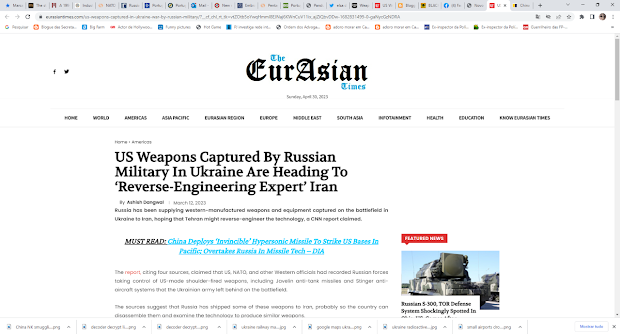Sunday, April 30, 2023
Saturday, April 29, 2023
(finland end stop of ukranian weapons deliverance) Ukraine Intel
https://www.euractiv.com/section/all/short_news/weapons-sent-to-ukraine-may-have-ended-up-in-finnish-underground/
Ukraine Intel - Once the planes are down, the equipment is unloaded onto Ukrainian trucks which then transport their precious cargo directly to the conflict zones (military equipment) or to areas in need (humanitarian aid). However, this airport has also become a potential target for Russian sabotage and security has been drastically increased. A Polish and American detachment is on site to help with the unloading of planes but also to secure the area. Moreover, the base also serves as a logistical hub for the contingent of the 82nd US Airborne Division, positioned 45 km northwest of this airport (Milec airport).
Friday, April 28, 2023
Thursday, April 27, 2023
Portugal Intel ( portuguese army at RCA )
https://www.portugalresident.com/portuguese-military-accused-of-crimes-against-humanity-in-central-african-republic/
Wednesday, April 26, 2023
Portugal - Russia Intel (military)
The cat-and-mouse game over Europe between Russian war planes and NATO fighter jets has prompted commentators to speculate whether it is all a gigantic plot to drain national air forces of fuel.
The latest antics over the Algarve would suggest that it could be.Russian Tupolev bombers “overflew” international air space under Portuguese jurisdiction for the second time last week, pushing further into national territory and only turning back after flying as far as Sagres.
The new incursion saw Portuguese F-16s based in Leiria racing to intercept, but this time both fighter jets ran out of fuel.
A third was bring scrambled as the Tupolevs turned back, leading one Portuguese leader writer to conclude “Russia’s strategy is to lead us all into bankruptcy!”
Correio da Manhã deputy editor Miguel Ganhão added: “If they continue with their flights over national territory, we won’t have any money left to fly our planes”.
Tuesday, April 25, 2023
Portugal Intel (gold)
https://www.moveaveiro.pt/en/les-reserves-dor-du-portugal-dune-valeur-soudaine-de-plus-de-20-milliards-deuros
Sudan Intel (part 2)
On November 11, Interfax reported that a draft proposal was worked out between Russia and Sudan for creating a logistic support base at Port Sudan. Though both countries have yet to make an official decision on this mater, talks about a Russian naval base, or at least a support base, have been ongoing since 2017. Should this logistic support base become a reality, Russia would be able to support a permanent naval presence in the Red Sea and Gulf of Aden and possibly project power into the Indian Ocean as well.
As for security, Sudan will be responsible for securing the exterior of the logistic support base but Russia will allegedly also be allowed to set up temporary military posts in Sudan to guard its support base. Russia will be also responsible for protecting the base from the seaside, provide air defense and maintain internal security inside the base. With Russia being responsible for the air defense of the support base, it seems that the free delivery of air defenses is taken out of context. Rather, Russia will deploy air defense systems that protects it support base and that this protection is also extended to the Sudanese naval base north of Port Sudan.
As for the type of deployments the Russian Navy could undertake from the logistic support base in Sudan, a lot remains open to speculations and will depend the final draft of the agreement. Needless to say, the support base a Port Sudan could function in the same manner as the Russian naval base at Tartus, Syria, functions but to a lesser scale. Tartus allows Russia to keep a small surface action group permanent deployed in the Eastern Mediterranean.
Special attention is to be given to the phrase that nuclear powered vessels can dock in Port Sudan. Should Sudan agree to this, then the Kirov class battle cruisers and nuclear submarines of the Russian Navy could, in theory, dock at and deploy from Port Sudan. Using Port Sudan in order to supply and sustain the deployment of nuclear submarines into the Indian Ocean
https://russianfleetanalysis.blogspot.com/2020/11/a-russian-logistic-support-base-in-sudan.html
Monday, April 24, 2023
Sudan Intel (part 1 )
Both Burhan and Hemedti have worked to encourage the U.S. to continue its counter-terrorism cooperation with Sudan. Their aim is to convince the U.S. to drop its support for popular calls for democracy and accept their autocratic military rule.
These goals encouraged Burhan and Hemedti to send high-level military envoys to Israel before carrying out their military coup on Oct. 25, 2021. On the security front, the aim of these meetings was to establish joint intelligence and security relations. It was agreed that the Sudan office of Hamas, identified by both Israel and the U.S. as a terrorist organization, would be closed. Politically, the meetings were part of the military’s effort to get Israel to lobby the U.S. to accept the upcoming coup in Sudan. The Sudanese military has deepened its security relations with Israel in the hope that Israel will press Washington to restart its financial assistance to Khartoum, worth $850 million, and for the international community to reinstate its forgiveness of Sudan’s $60 billion debt.
The Biden administration has also stepped up U.S. involvement in East Africa to protect its interests and allies from al-Shabaab, deploying 450 soldiers into Somalia following a spike in al-Shabaab attacks, which rose 17% in 2021 and were projected to rise by 71% this year
Burhan and Hemedti have also used the potential establishment of a Russian naval base in Port Sudan, in eastern Sudan’s Red Sea coast, as another means of pressuring the U.S. to acquiesce in backing their rule, rather than supporting democracy.
The divisions between Burhan and Hemedti have come into play here as well. Hemedti, who visited Russia on the eve of its invasion of Ukraine, has welcomed Moscow’s bid to build a naval base in Sudan. The Russian private security company Wagner Group has been operating in Sudan with the support of Hemedti’s paramilitary Rapid Support Forces (RSF), extracting minerals for export back home; it is also believed that Wagner is supporting and training the RSF to spread disinformation on social media to counter calls for democracy.
Sudan and China have deep economic ties in various fields, including agriculture, energy, and mining. Sudan’s exports to China in 2020 reached $766 million, accounting for 19% of its total exports and making China its second-largest trading partner. The strength of bilateral relations explains China’s veto of U.N. Security Council resolutions against Burhan and Hemedti’s coup.
https://www.mei.edu/publications/us-priorities-sudan-stability-or-democracy
Portugal Intel (ammunition suplliers)
Pt suplliers:
Miliciapro Alsatex Demag cranes & components lda ( also missiles) Euroarmas lda Lasi electronica lda Qualifire import export lda Studia Espingardaria central A montez sa Antero lopes lda Protilis Portugal lda Cacicambra sa Sodarca Lissa lda Thomarbraulio ldaRussia-Ukraine War Intel - NATO's plan, another Normandie at Dnipro River
Electricity is generated by both hydro and nuclear power plants. Much of the hydro-power is generated on the Dnipro. Many nuclear reactors are west of the Dnipro.
The rigorous slimming of these units would free up nearly 2500 guns and heavy mortars, 1400 tanks, and an equivalent number of infantry fighting vehicles to provide basic equipment for 50 infantry divisions. Some would say that this use of scarce armor is a mistake, but the historical record suggests that small armored tactical reserves greatly stiffen the defensive power of infantry units. Trucks and engineering assets for these divisions would need to be mobilized out of the civilian economy.
The less mobile air defense assets that Ukraine has inherited from the old Soviet strategic air defense system would provide the basis for air defense belts along the Dnipro and the Belarussian border. Anti-tank guided missiles (ATGM's) currently owned by Ukraine would be distributed across these divisions. As financial resources become available additional ATGMs would be acquired. Substantial numbers of more basic anti-tank weapons-- shoulder fired rockets, large caliber recoilless rifles, and towed high velocity anti-tank guns would be collected from existing military units, or manufactured. Finally, to compensate for the relatively sparse artillery assets in these units, very large numbers of medium mortars (82mm) would be acquired. (120 mm mortars would be better, but they are counted under the artillery ceilings in CFE, and thus Ukraine cannot acquire more of them.) A notional divisional TOE (table of organization and equipment) is presented below
This division should be able to populate with its units and weapons 20-25 km of front in depth with sufficient density, to create substantial problems for an attacker
A 50 division force of infantry divisions would permit a reasonably dense defense of some 1000-1250 km. This is not quite enough, given the 1400 km of northern and eastern perimeter that the bastion will have to defend. Thus, even this force will require very careful management. It may be true that some parts of both lines of resistance offer sufficiently difficult terrain that they can be defended even more economically. The Dnipro line will require a major water-crossing operation by Russian forces; some portions of the river appear to be virtual lakes on a map, and cannot simply be bridged.
Sunday, April 23, 2023
Saturday, April 22, 2023
Portugal Intel (SIRP and Army fiber optics cables direct connection)
https://www.base.gov.pt/Base4/pt/pesquisa/?type=contratos&texto=SIRP+&tipo=0&tipocontrato=0&cpv=&aqinfo=&adjudicante=&adjudicataria=&sel_price=price_c1&desdeprecocontrato=&ateprecocontrato=&desdeprecoefectivo=&ateprecoefectivo=&sel_date=date_c1&desdedatacontrato=&atedatacontrato=&desdedatapublicacao=&atedatapublicacao=&desdeprazoexecucao=&ateprazoexecucao=&desdedatafecho=&atedatafecho=&pais=0&distrito=0&concelho=0
Friday, April 21, 2023
Portugal Intel (TAP scandal 3)
https://www.essential-business.pt/2023/04/19/tap-neeleman-team-received-bonuses-and-salaries-worth-millions/
https://web3.cmvm.pt/sdi/emitentes/docs/FR77135.pdf
Tuesday, April 18, 2023
Portugal Intel (TAP scandal )



.png)
.png)


































.png)
.png)
.png)
.png)
.png)








